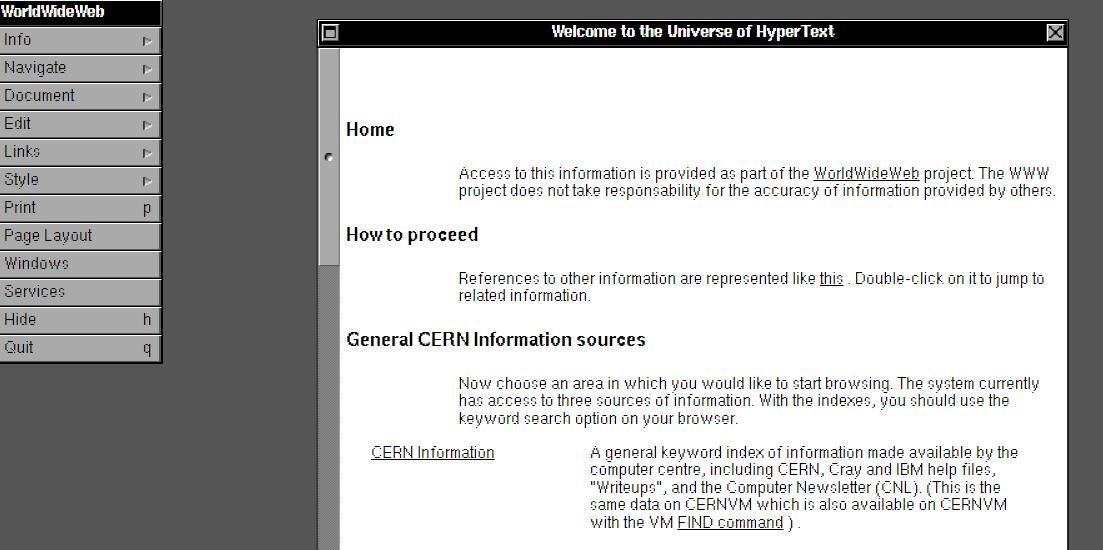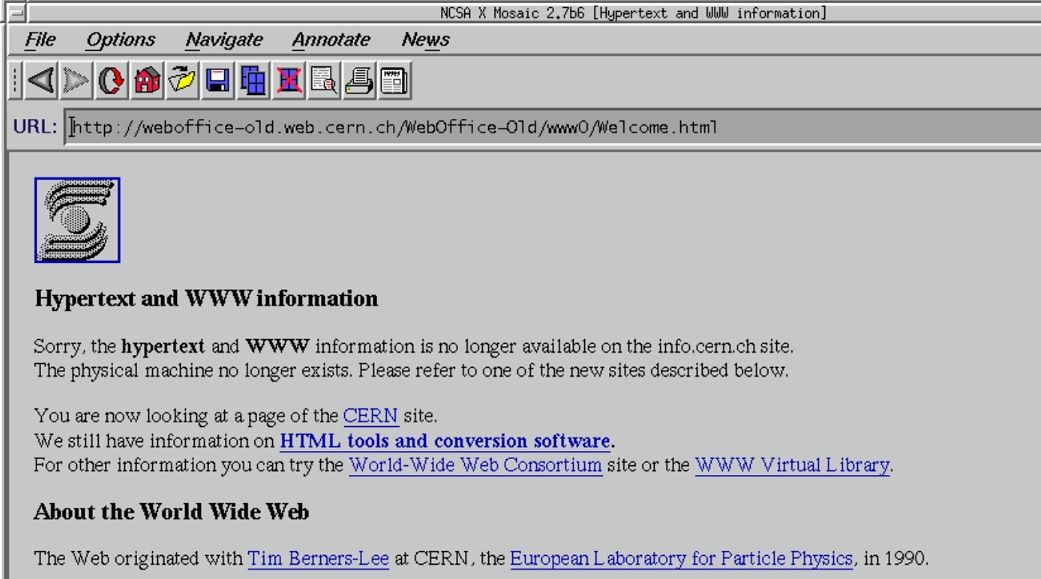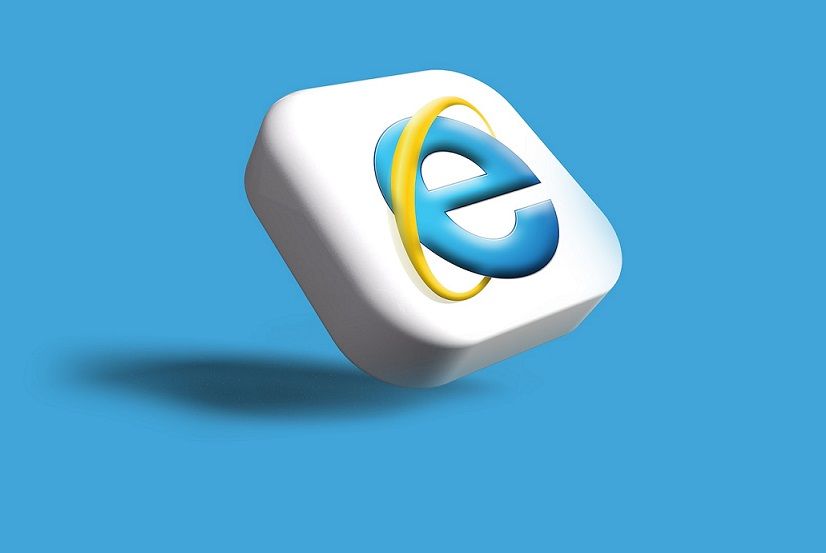The World Wide Web is a collection of billions of interlinked websites accessible on the global computer network known as the internet. Wide area networking (WANs) predated the World Wide Web for decades.
However, it wasn’t until Tim Berners Lee invented websites in 1989 that the internet of today was truly born. The World Wide Web has been evolving ever since. So, here we take a look at the history of the WWW from its conception in 1989 up to the present in 2023.
1989-1993: Tim Berners-Lee Invents the World Wide Web
Tim Berners-Lee was a scientist working at CERN (European Organization for Nuclear Research) in the late 1980s and early ‘90s. CERN’s need to share data prompted Tim Berners-Lee to submit a draft proposal for a new kind of distributed information system. That document outlined the idea of linking pages with hypertext. In 1990, Lee submitted another document titled “WorldWideWeb” that included an extended outline for a new hypertext project.
By the end of 1990, Tim had laid the foundations of the modern-day World Wide Web. He developed the first web browser, which was called WorldWideWeb. You can see what that browser was like on this WorldWideWeb page. Tim also established the world’s first server on his NeXT computer in 1990.
Everything was then ready for the first website in 1991. Tim hosted the first website on his NeXT server titled “World Wide Web” in that year. It provided a brief introduction to the World Wide Web by describing it as a wide-area information initiative for accessing many documents. That first website remains online today, and you can view it on a dedicated CERN site.
The final milestone in the early development of the World Wide Web came in 1993. Then Tim Berners-Lee and CERN submitted a document placing the web in the public domain. That document further defined the World Wide Web and confirmed CERN did not claim any intellectual ownership rights of it. Therefore, nobody owns the Web as CERN adopted an open for all policy.
1992-1995: The First Graphical Browsers
The WorldWideWeb browser Tim developed was little more than a text editor. It wasn’t until 1992 the first graphical browsers that could handle images emerged. Young programmers in Finland developed the first graphical browser and named it Erwise. However, the developers of Erwise did not seek to commercialize it, and the browser never took off.
NCSA released Mosaic in 1993, the first graphical browser that popularized browsing. Mosaic could display images alongside text. Users could now view websites that incorporated text, images, videos, and sound for the first time within Mosaic. Mosaic soon became the biggest browser, with a user base eclipsing the one-million mark.
However, Mosaic would not remain the world’s foremost web browser for long. Microsoft released Internet Explorer in 1995 and bundled it with their Windows platforms. Internet Explorer emerged victorious in the first browser war, with a user base share reaching the 90 percent mark in its heyday. Internet Explorer has quite a history itself, but we won't dive into that too much here.
1995: JavaScript Shakes Up the Web
Websites during the World Wide Web’s early years were rather basic. However, that started to change in 1995 when the programmer Brandan Eich developed the JavaScript scripting language for webpages.
JavaScript soon became one of the core languages for website development alongside HTML and CSS. It enabled website designers to add interactive elements to pages and create more dynamic sites.
1995-2000: The Dot.com Boom
It didn’t take long for the first entrepreneurs to recognize the commercial potential of websites during the dot.com boom. Jeff Bezos founded the Amazon site in 1995. Though Bezos originally called it Cadabara (a magical spell), he later chose Amazon, one of the world’s longest rivers, to be the name. Amazon started as a website selling books but expanded to sell much, much more as it became the world’s largest online retailer.
The computer scientists Sergey Brin and Larry Page founded the Google search engine and company during 1997-1998. The Google search engine was originally called BackRub, but Brin and Page soon renamed it. It was supposed to be called Googol, but a typo established the Google domain name. That search engine quickly became one of the most popular tools for finding webpages, and Mr. Brin and Page established the Google company in 1998.
1999-2003: The First Blogging Platforms Were Established
Blogs (online web diaries and journals) became the new big thing on the World Wide Web during 1999-2003. Blogger was one of the first notable blogging platforms established in 1999 that enabled users to set up online journals from templates. Users could now establish an online presence without needing to design and upload websites with software.
WordPress was another big blogging platform founded a few years after Blogger in 2003. It started as a blog-publishing platform, much the same as Blogger. However, it was extended to become a broader web-publishing platform that enabled users to set up websites based on WordPress templates. Those websites include comment sections in which readers can reply to posts in much the same way as conventional blogs.
2004-2006: The Rise of Social Media
In 2004, Mark Zuckerberg founded Facebook. Facebook was among the first websites to popularize social media. Zuckerberg designed Facebook to be a blue site because of his red-green color-blinded vision. The sharing of content, opinions, and information via online communities and networks Facebook facilitated became known as social media.
Twitter later expanded the social media phenomenon Facebook started. Jack Dorsey founded Twitter in 2006, and it became one of Facebook’s biggest social media rivals, with explosive growth from 2009. Many users fell in love with Twitter’s tweet messaging, which made it a more popular social networking platform for journalism. This Twitter history walkthrough tells you about the Twitter story from 2006 up to Musk’s acquisition.
2006: Google Unleashes Docs, Sheets, and Slides
Cloud computing became the buzzword of the World Wide Web when Google launched the online Docs, Sheets, and Slides productivity apps in 2006. Those are the word processor, spreadsheet, and presentation applications of Google Workspace (originally Google Apps for Your Domain).
Docs, Sheets, and Slides enable users to produce documents, spreadsheets, and presentation slideshows in their web browsers without installing any productivity software.
2008-2012: Google Chrome Becomes the World’s Favorite Web Browser
Internet Explorer was still the world’s foremost web browser by 2008. It might have remained the king of browsers had Larry Page and Sergey Brin listened to the then Google CEO Eric Schmidt in 2008. Schmidt rejected the proposal for a Google web browser because he was convinced Microsoft would kill such a product.
However, Page and Brin didn’t listen and enlisted former Firefox developers to develop a demo version of Chrome. Those developers later duly informed Schmidt of the new Chrome browser, leaving the Google CEO little choice but to approve it. Google duly released Chrome in 2008, which overtook Internet Explorer’s user base in 2012 to become the world’s favorite web browser.
2015: Microsoft Launches Edge
Microsoft could only watch in horror as Internet Explorer’s user share plummeted in the years after. As Internet Explorer struggled to compete with Chrome, the big M released the Edge browser in 2015. After a bit of a slow start, Edge has grown in stature since Microsoft converted it to a Chromium engine. However, Chrome still has a considerably bigger user base than Edge.
2020: HTML 5 Replaces Adobe Flash
Adobe Flash was once the dominant multimedia content format on the World Wide Web. It was used for adding multimedia content, such as animations and videos, to websites. Many website games were also based on Adobe Flash.
However, things began to change after the introduction of HTML 5 from 2008 onward. HTML 5 is the most advanced HyperText Markup Language version that has now largely replaced Adobe Flash. Steve Jobs snubbed Flash on Apple’s iPhones in favor of HTML 5. Flash’s security vulnerabilities were another significant factor in its demise. Consequently, Adobe discontinued Flash support in 2020.
2022-2023: The Web 3.0 Boom and the Coming of AI
Web 3.0 is the next iteration of the World Wide Web, which Tim Berners-Lee has spoken about with news channels in recent years. That is the next stage of the web Tim envisages will be more decentralized with a bottom-up design. Tim has also spoken about AI being a big part of the web’s future evolution, with more AI assistants like ChatGPT supporting browsing.
The Web Changed the World
The World Wide Web is 34 years old as of March 2023. It was undoubtedly one of the greatest inventions of the 20th century alongside cars, airplanes, PCs, and televisions. The invention of a global website network ushered in a new communications and information revolution throughout the globe. But do you know the difference between the internet and the World Wide Web?









